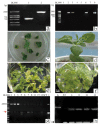PhCHS5 and PhF3'5'H Genes Over-Expression in Petunia (Petunia hybrida) and Phalaenopsis (Phalaenopsis aphrodite) Regulate Flower Color and Branch Number
- PMID: 37299183
- PMCID: PMC10255828
- DOI: 10.3390/plants12112204
PhCHS5 and PhF3'5'H Genes Over-Expression in Petunia (Petunia hybrida) and Phalaenopsis (Phalaenopsis aphrodite) Regulate Flower Color and Branch Number
Abstract
Flower breeders are continually refining their methods for producing high-quality flowers. Phalaenopsis species are considered the most important commercially grown orchids. Advances in genetic engineering technology have provided researchers with new tools that can be used along with traditional breeding methods to enhance floral traits and quality. However, the application of molecular techniques for the breeding of new Phalaenopsis species has been relatively rare. In this study, we constructed recombinant plasmids carrying flower color-related genes, Phalaenopsis Chalcone synthase (PhCHS5) and/or Flavonoid 3',5'-hydroxylase (PhF3'5'H). These genes were transformed into both Petunia and Phalaenopsis plants using a gene gun or an Agrobacterium tumefaciens-based method. Compared with WT, 35S::PhCHS5 and 35S::PhF3'5'H both had deeper color and higher anthocyanin content in Petunia plants. Additionally, a phenotypic comparison with wild-type controls indicated the PhCHS5 or PhF3'5'H-transgenic Phalaenopsis produced more branches, petals, and labial petals. Moreover, PhCHS5 or PhF3'5'H-transgenic Phalaenopsis both showed deepened lip color, compared with the control. However, the intensity of the coloration of the Phalaenopsis lips decreased when protocorms were co-transformed with both PhCHS5 and PhF3'5'H. The results of this study confirm that PhCHS5 and PhF3'5'H affect flower color in Phalaenopsis and may be relevant for the breeding of new orchid varieties with desirable flowering traits.
Keywords: Flavonoid 3′,5′-hydroxylase; Petunia; Phalaenopsis; anthocyanin; chalcone synthase.
Conflict of interest statement
The authors declare that they have no conflict of interest.
Figures





References
-
- Christenhusz M.J.M., Byng J.W. The number of known plants species in the world and its annual increase. Phytotaxa. 2016;261:201–217. doi: 10.11646/phytotaxa.261.3.1. - DOI
-
- Tomizawa E., Ohtomo S., Asai K., Ohta Y., Takiue Y., Hasumi A., Nishihara M., Nakatsuka T. Additional betalain accumulation by genetic engineering leads to a novel flower color in lisianthus (Eustoma grandiflorum) Plant Biotechnol. 2021;38:323–330. doi: 10.5511/plantbiotechnology.21.0516a. - DOI - PMC - PubMed
Grants and funding
LinkOut - more resources
Full Text Sources

